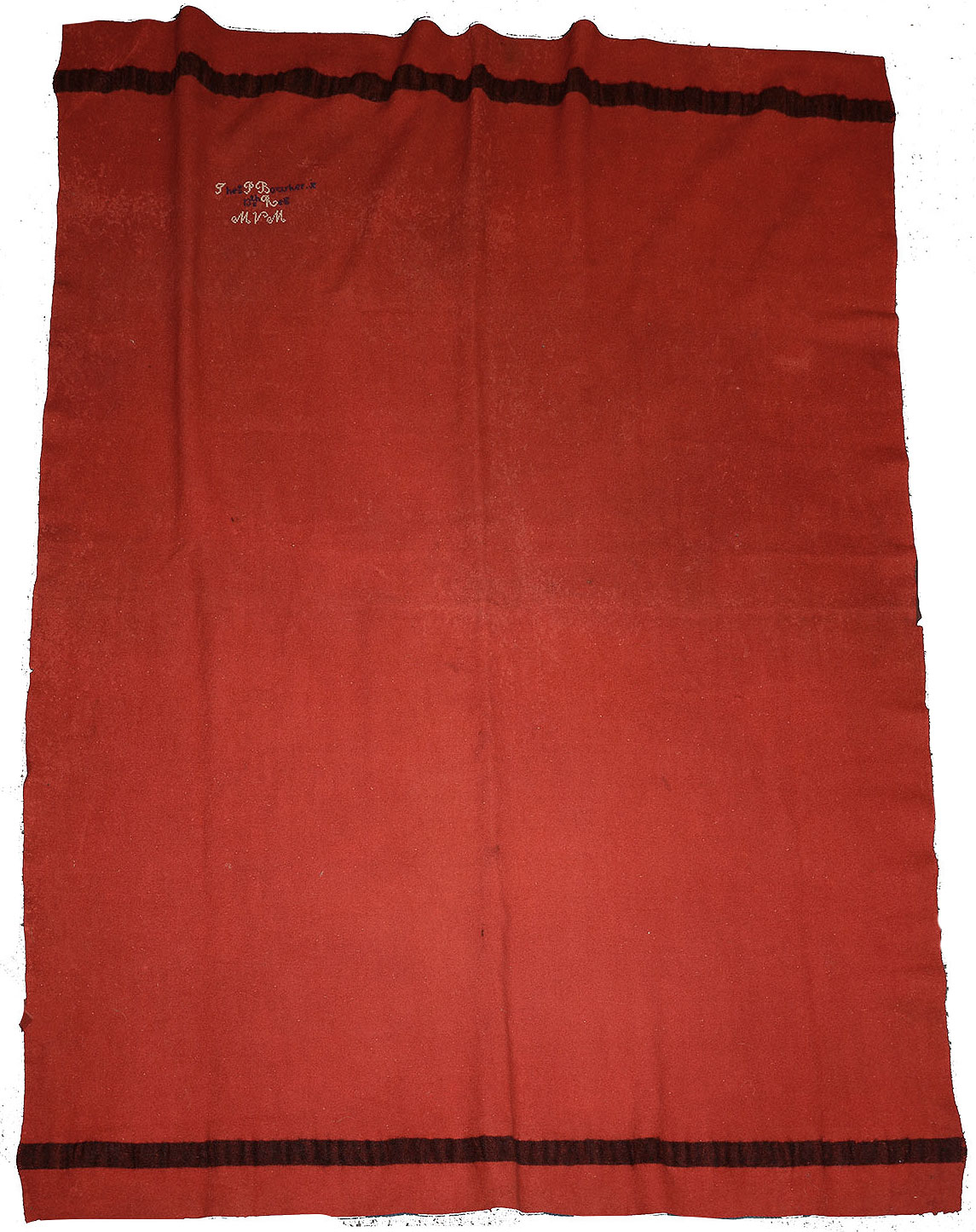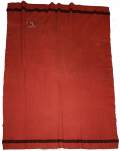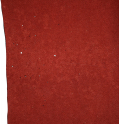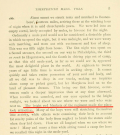site search
online catalog
IDENTIFIED ISSUE RED BLANKET OF THEODORE P. BOWKER 13th MASS, DIED OF WOUNDS AT ANTIETAM!

$7,500.00
Quantity Available: 1
Item Code: 490-7138
Shipping: Determined by Method & Location of buyer
To Order:
Call 717-334-0347,
Fax 717-334-5016, or E-mail
This is a rare, early-war, identified Massachusetts issue red blanket carried by a soldier in the 13th Massachusetts who was wounded at Antietam on Sept. 17, 1862, and died of those wounds at a U.S. hospital at Rappahannock Station on November 12. Red issue blankets are well documented, particularly early in the war and in regiments from New England, whose mills likely supplied them, but are known to have been carried in some New York, Pennsylvania, and some western regiments as well. They are particularly well documented for the 13th Mass, being mentioned in the regimental history as carried in the field in a story about camping at Boonsboro, MD, in late August 1861.
Any Civil War issue blanket is scarce, and red examples particularly so. This one is in excellent condition, with strong color, red with black end stripes, and the fabric showing only some scattered very small holes. It measures 58 inches by 80 inches, and has the soldier’s name and unit embroidered at the upper left, below one end strip, in letters 1” and ½” tall, reading: “Theo P Bowker, Jr / 13th Reg / MVM.” Most of the letters are in dark blue, with the initial letters in script and in white, as is the “MVM,” creating a patriotic red, white and blue effect, with the ends are bound in a narrow, lighter blue. The embroidery, and perhaps the edge binding, was likely done by a loved one at home, if not by Bowker or a comrade. Bowker was a member of Company A, which had been Company A of the 4th Battalion of Rifles, Mass. Volunteer Militia. The company was the old Boston City Guard, which split off from its old regiment in December 1860 and formed the nucleus of the 4th Battalion, which in turn became the nucleus of the 13th Mass. Regiment. Whether Bowker was long-time member or recent recruit enlisted to bring the company up to war strength is unclear: his date of muster is July 16, the official date of muster into US service for the entire regiment. Company A and the rest of the 4th Battalion had been in garrison at Fort Independence, Boston harbor, from May 25, 1861, while the regiment was organized and drilled, until its departure for the front on July 29. Company A likely had it blankets already when it entered the fort: the first companies were noted as carrying knapsacks and blankets. But, in listing the items issued at the fort the regimental history includes blankets and notes that soldiers were responsible for any items lost: “as you had to pay for the articles issued, there was no objection on the part of the government to your throwing them all away, if it pleased you to do so…” There was thus lots of incentive to mark one’s gear to prevent theft or loss. That the regiment’s blankets were red is specifically stated in the regimental history, noting that they had settled into a camp at Boonsboro, MD, in August after dark and, “When reveille was sounded, and our eyes opened, we looked about to see where we were and who were near us. The bright red blankets of the regiment made the place look attractive.” This is a passing reference in a humorous anecdote since it also became clear in the daylight that the attractive camp had been in fact been made in a mule yard.
Theodore Persons Bowker, Jr., was 20 when he mustered into service. The 1860 census records him living at home with his father and mother in Boston, and working as a clerk. If he or a comrade did not do the embroidery on the blanket, his mother may well have. We note his unit is embroidered as “13th M.V.M.” though it was the 4th Rifles that was in the Massachusetts Volunteer Militia and the 13th Mass was technically the Mass. Volunteers, but that fine distinction was likely beyond most recruits at least while the regiment was being organized. The regiment left Boston on July 29 and did its first service in Maryland in a division commanded by Banks and assigned to guarding fords along the Potomac. (It ironic given Bowker’s fate that they were posted at Sharpsburg early on.) The duty did, however, give them some taste of combat in small unit actions while on picket, outpost and scouting duty, including encounters with Confederate cavalry and repeated Confederate efforts to destroy Dam #5.
In March 1862 the regiment became part of Banks’s 5th corps, Army of the Potomac, served in the Shenandoah and then moved to northern Virginia, becoming part of McDowell’s 3rd Corps, Army of Virginia in May. Bimonthly company muster rolls show Bowker absent only for a time in the May-June time frame when he was sick in hospital at Manassas Junction. This puts him back in the ranks in time for Pope’s Virginia Campaign and then Antietam. The regiment was present but not engaged at Cedar Mountain in late August and saw its first serious fighting at Thoroughfare Gap and then 2nd Bull Run, where it was heavily engaged, losing 36 officers and men killed or mortally wounded. In September they became part of Hooker’s 1st Corps, Hartsuff’s brigade, and was engaged at South Mountain, without loss, on Sept. 14, but at Antietam they lost heavily in the fighting in the Cornfield and near Dunkard Church. According to one source they carried 301 officers and men into action, losing 136, including Bowker, who was one of 21 killed or wounded in Company A.
The nature of Bowker’s wound is not specified. He was likely treated first at one of the field hospitals, but by October had been evacuated to the “School House Hospital” at Chambersburg, PA. He would have been thought safe behind the lines at that point, but was one of the Union sick and wounded captured and paroled there on October 11 by Confederate cavalry during Jeb Stuart’s October 10-12 raid around McClellan’s army, usually called simply his “Chambersburg Raid” or his “second ride around McClellan.” He was transferred at some point after that to a hospital at Rappahannock Station, where he died of his wounds on November 12. His body was sent home for burial, whether paid for by his comrades or family is unclear, but eventually interred at Norwell, Mass. It is possible the blanket was sent home at that point as part of his personal effects since it is so well marked, though he may well have sent it home earlier at some point. In any case, this is a very scarce piece of soldier’s gear, with a great deal of eye appeal and connection to one of the war’s most famous battles, as well as a memento of a family’s loss. [sr] [ph:L]
~~~~~~~~~~~~~~~~~~~~~~~~~~~~~~~~~~~
THIS ITEM, AS WITH ALL OTHER ITEMS AVAILABLE ON OUR WEB SITE,
MAY BE PURCHASED THROUGH OUR LAYAWAY PROGRAM.
CLICK HERE FOR OUR POLICIES AND TERMS.
THANK YOU!
Inquire About IDENTIFIED ISSUE RED BLANKET OF THEODORE P. BOWKER 13th MASS, DIED OF WOUNDS AT ANTIETAM!
For inquiries, please email us at [email protected]
Most Popular
Historical Firearms Stolen From The National Civil War Museum In Harrisburg, Pa »
Theft From Gravesite Of Gen. John Reynolds »
Selection Of Unframed Prints By Don Troiani »
Fine Condition Brass Infantry Bugle Insignia »
Wonderful Condition Original Confederate-Manufactured Kepi For A Drummer Boy Or Child »
featured item
MISSOURI CONFEDERATE FROCK COAT, SASH, CS SWORD BELT, AND HOLSTER, OF MAJOR WILLIAM F. HAINES, WITH FAMILY ARCHIVE OF PHOTOS & PAPERS: SHILOH, VICKSBURG, AND NEGOTIATIONS WITH SHERMAN FOR SURRENDER OF GEN. L.S. BAKER’S COMMAND IN APRIL 1865
This beautiful, identified Confederate major’s coat, sash, sword belt, sash, and holster, once in the Texas Civil War Museum, comes with two brown ink notes that were pinned to it, one reading: “Major W. F. Haines / Bowens Staff / Confederate… (1179-277). Learn More »









